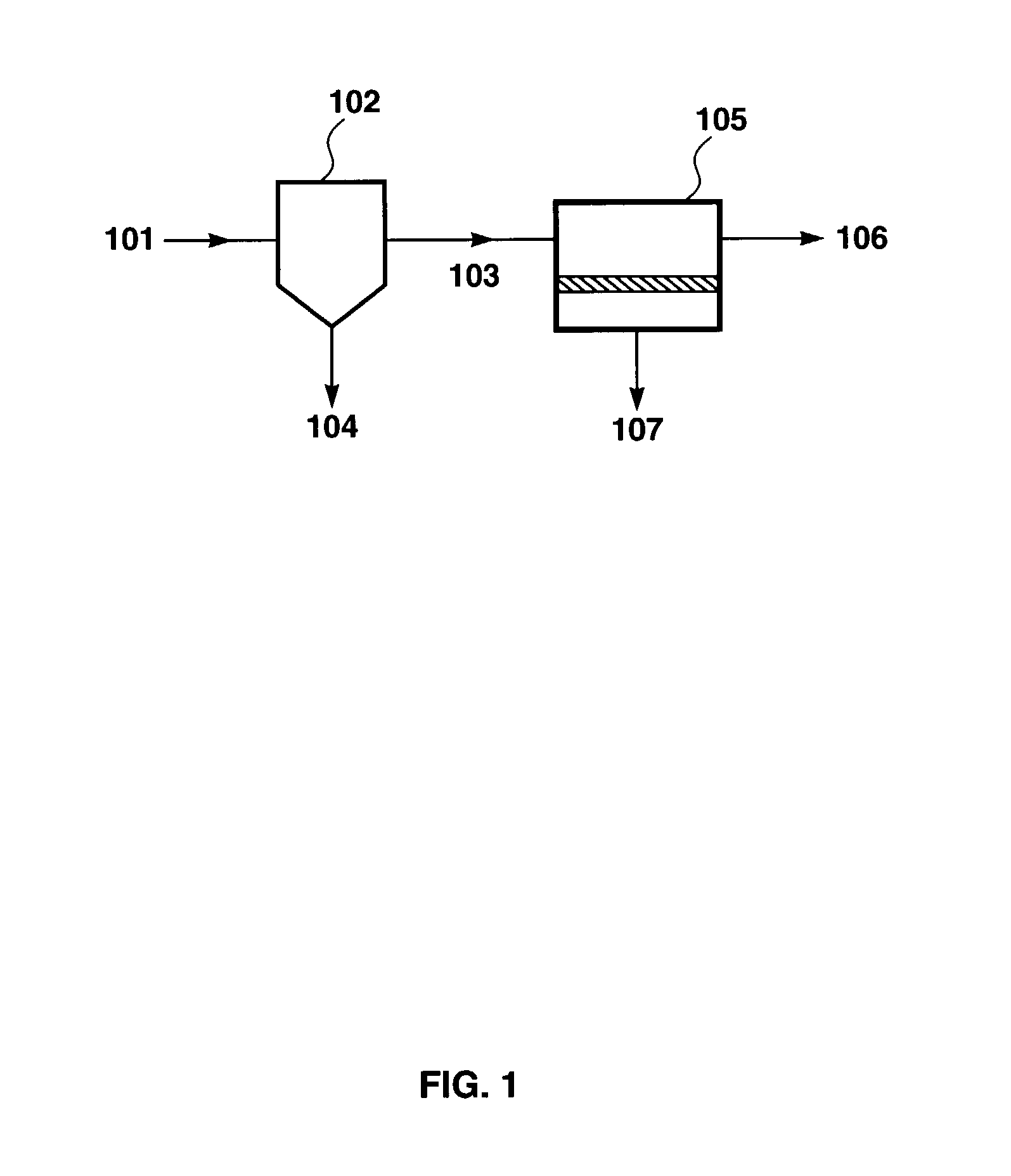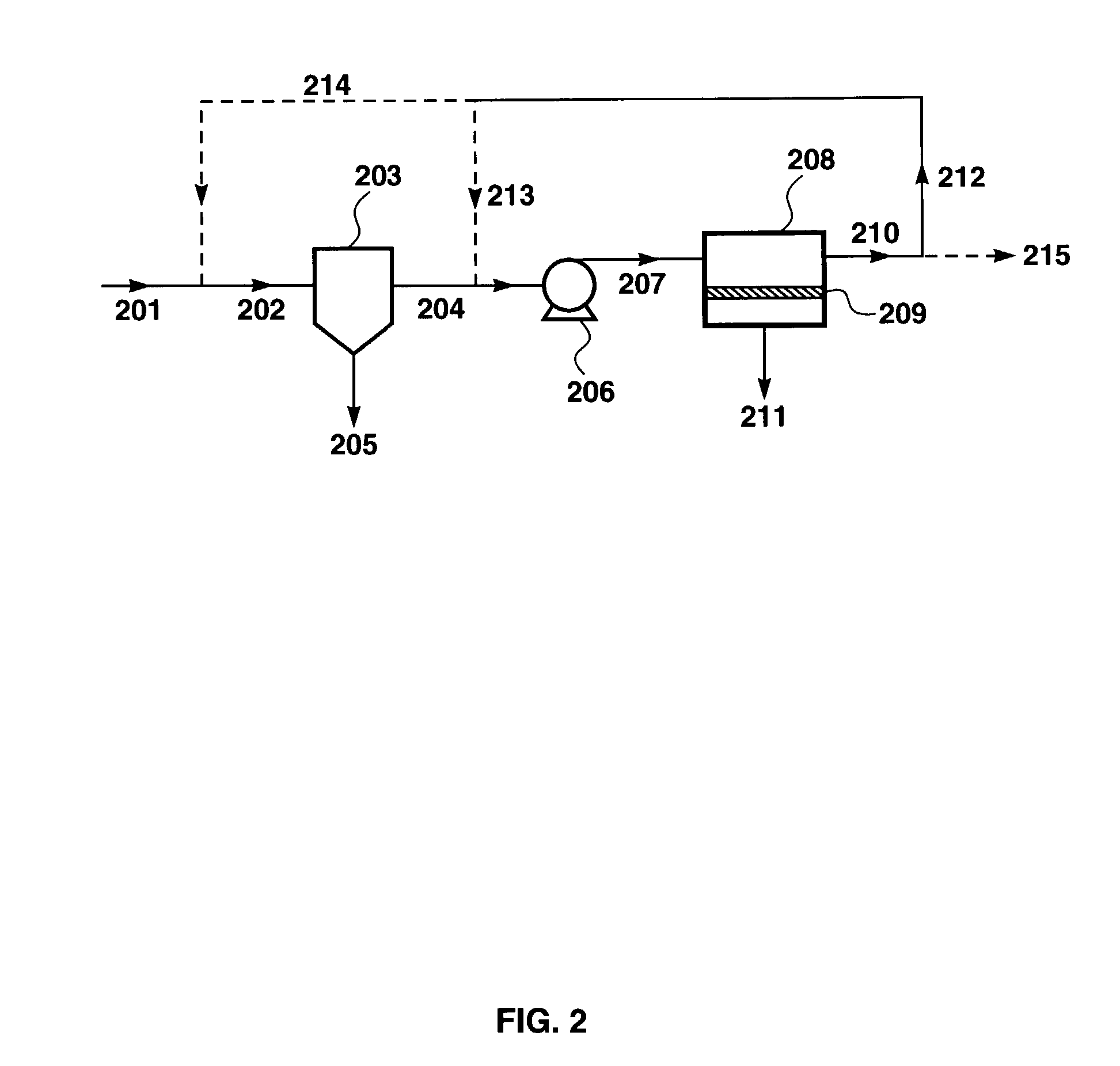Treatment of shipboard-generated oily wastewaters
- Summary
- Abstract
- Description
- Claims
- Application Information
AI Technical Summary
Benefits of technology
Problems solved by technology
Method used
Image
Examples
example 1
Membrane and Module Preparation
[0168]Composite membranes were made from both Pebax® 1074 and Pebax® 1647 grades (Atochem, Inc., Glen Rock, N.J.) in a two-step process. First, a microporous support layer of polyvinylidene fluoride (PVDF) was cast onto a fabric web. In the second step, the support layer was coated with the ultrathin Pebax® selective layer. After drying in an oven, a selective layer 0.5–2 μm thick was left on the support.
[0169]The selective layer thickness was determined by measuring the nitrogen flux of the composite membrane, from which the thickness of the selective layer was calculated using the known intrinsic nitrogen permeability of Pebax®. The carbon dioxide flux was also measured to ensure that the Pebax® layer was defect-free. This was done by comparing the carbon dioxide / nitrogen selectivity of the membrane with the known carbon dioxide / nitrogen selectivity of Pebax® films.
[0170]The defect-free membranes were incorporated into 2.5-inch-diameter spiral-wound ...
example 2
Permeation Properties of Modules with Model Solutions
[0172]Before beginning tests with simulated bilge water, the permeation properties of membrane modules, prepared as in Example 1, were measured with clean water and simple model solutions, using the module test system described above. During each test, the feed solution was circulated through the system at atmospheric pressure to allow the system to equilibrate. The system was pressurized only when the solute concentration in the feed had stabilized. This procedure ensured negligible accumulation of solute in the system during the tests, so that all changes in the feed composition were attributable to the membrane process.
[0173]The solute rejections of the two modules were determined with dilute aqueous solutions of magnesium sulfate, polyethylene glycol, sucrose, trichloroethylene (TCE), and toluene. The feed temperature was 25° C. and the feed pressure was 50 psig. The fluxes and solute rejections for Pebax® 1074 and Pebax®1657 ...
example 3
Comparative Example
[0176]An experiment was performed to compare the flux properties of a Pebax® 1657 composite membrane with those of a commercial ultrafiltration membrane, Membrex X-50 (Osmonics, Minnetonka, Minn.). The Pebax® membranes were prepared as in Example 1; the Membrex membranes were tested as supplied from the manufacturer. Samples of the membranes were cut into 12-cm2 stamps and were tested in a permeation test cell for 72 hours at a feed pressure of 600 psig and a feed temperature of 60° C. The feed composition was 1 wt % crude petroleum in water. FIG. 5 compares the total permeate fluxes of the two membranes as a function of operating time.
[0177]As can be seen, the initial fluxes of the commercial membrane were much higher than those of the experimental membrane. After a day of operation, however, the Pebax® membranes retained their flux properties and had marginally higher fluxes than the commercial membranes, which had suffered a flux drop of about an order of magni...
PUM
| Property | Measurement | Unit |
|---|---|---|
| Fraction | aaaaa | aaaaa |
| Fraction | aaaaa | aaaaa |
| Fraction | aaaaa | aaaaa |
Abstract
Description
Claims
Application Information
 Login to view more
Login to view more - R&D Engineer
- R&D Manager
- IP Professional
- Industry Leading Data Capabilities
- Powerful AI technology
- Patent DNA Extraction
Browse by: Latest US Patents, China's latest patents, Technical Efficacy Thesaurus, Application Domain, Technology Topic.
© 2024 PatSnap. All rights reserved.Legal|Privacy policy|Modern Slavery Act Transparency Statement|Sitemap



